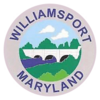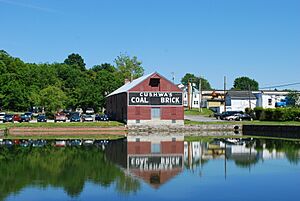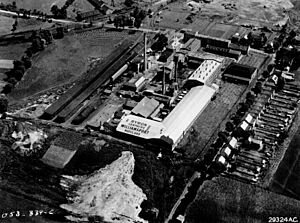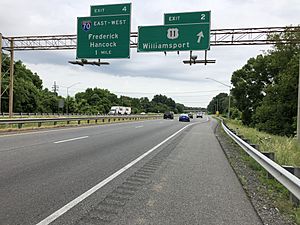Williamsport, Maryland facts for kids
Quick facts for kids
Williamsport, Maryland
|
|||
|---|---|---|---|
|
Town
|
|||
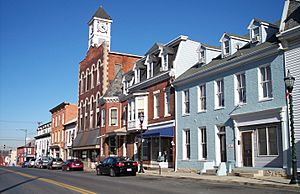
Conococheague Street in Williamsport in 2007
|
|||
|
|||

Location of Williamsport, Maryland
|
|||
| Country | United States | ||
| State | Maryland | ||
| County | Washington | ||
| Incorporated | 1823 | ||
| Government | |||
| • Type | Mayor–council | ||
| Area | |||
| • Total | 0.98 sq mi (2.55 km2) | ||
| • Land | 0.98 sq mi (2.55 km2) | ||
| • Water | 0.00 sq mi (0.00 km2) | ||
| Elevation | 420 ft (130 m) | ||
| Population
(2020)
|
|||
| • Total | 2,083 | ||
| • Density | 2,119.02/sq mi (817.91/km2) | ||
| Time zone | UTC-5 (Eastern (EST)) | ||
| • Summer (DST) | UTC-4 (EDT) | ||
| ZIP code |
21795
|
||
| Area code(s) | 301, 240 | ||
| FIPS code | 24-85100 | ||
| GNIS feature ID | 2391487 | ||
| Website | http://williamsportmd.gov/ | ||
Williamsport is a small town located in Washington County, Maryland, in the United States. It's a place with a rich history, especially because of its location near the Potomac River and important transportation routes. In 2020, about 2,083 people lived there.
Contents
Where is Williamsport?
Williamsport is in the western part of Maryland. It covers an area of about 1.04 square miles (2.69 km2), which is all land. The town is located about 7.69 mi (12.38 km) southwest of Hagerstown. It is also about 16.23 mi (26.12 km) north of Martinsburg, West Virginia.
What is the climate like?
Williamsport has a climate with hot and humid summers. The winters are usually mild to cool. This type of weather is called a humid subtropical climate.
Who lives in Williamsport?
| Historical population | |||
|---|---|---|---|
| Census | Pop. | %± | |
| 1850 | 1,091 | — | |
| 1860 | 1,016 | −6.9% | |
| 1870 | 1,283 | 26.3% | |
| 1880 | 1,503 | 17.1% | |
| 1890 | 1,277 | −15.0% | |
| 1900 | 1,472 | 15.3% | |
| 1910 | 1,571 | 6.7% | |
| 1920 | 1,615 | 2.8% | |
| 1930 | 1,775 | 9.9% | |
| 1940 | 1,772 | −0.2% | |
| 1950 | 1,890 | 6.7% | |
| 1960 | 1,853 | −2.0% | |
| 1970 | 2,270 | 22.5% | |
| 1980 | 2,153 | −5.2% | |
| 1990 | 2,103 | −2.3% | |
| 2000 | 1,868 | −11.2% | |
| 2010 | 2,137 | 14.4% | |
| 2020 | 2,083 | −2.5% | |
| U.S. Decennial Census | |||
In 2010, there were 2,137 people living in Williamsport. These people made up 960 households. Most of the people living in Williamsport were White (95.6%). About 2.5% were African American.
The average age of people in Williamsport in 2010 was 44.9 years old. About 19% of the residents were under 18. Also, 23.4% were 65 years old or older.
Famous people from Williamsport
Some notable people have come from Williamsport:
- Nick Adenhart: A former professional baseball pitcher.
- Dave Cole: Another former professional baseball pitcher.
- Gina Marie Groh: A judge for the United States District Court.
Williamsport's History
Williamsport is located on an old trail used by Native Americans. In the 1700s, many European families used this same path. They traveled on the Great Wagon Road from Pennsylvania to Virginia. In 1744, a ferry was started in Williamsport. This ferry helped people and wagons cross the Potomac River. Today, travelers use Interstate 81 to cross the river.
In 1755, Williamsport became an important supply spot. This was for the British army during the French and Indian War. Supplies were brought here before being moved to other places.
The town is named after Otho Holland Williams. He was an officer in the Continental Army during the American Revolutionary War. He used to own the land where Williamsport is now.
Several historic places in Williamsport are listed on the National Register of Historic Places. These include Cedar Grove and the Williamsport Historic District.
How Williamsport grew
In 1834, the Chesapeake and Ohio Canal reached Williamsport. This canal connected the town to Washington, D.C. The canal was very important for trade. It helped connect Williamsport to the lower Potomac River and the Chesapeake Bay. Later, it connected to Cumberland, Maryland. Williamsport became a busy town because of the canal.
In 1873, the Western Maryland Railway built a train line to Williamsport. This helped move goods between the canal and the trains. Coal from Cumberland was often moved from canal boats to train cars here.
Flooding events
During the American Civil War in 1863, the Potomac River flooded. This flood stopped General Robert E. Lee's army. They were retreating from the Battle of Gettysburg. The flood prevented them from crossing the river for several days. In 1924, a very large flood badly damaged the canal. After this, the canal was permanently closed.
What's new in Williamsport?
The historic center of Williamsport was added to the National Register of Historic Places in 2001. It is known as the Williamsport Historic District.
In 2010, the town hired Michael Sparks to help improve downtown Williamsport. He wanted to attract more tourists. He created a plan called C.A.R.E.
- Connecting: Making the town's attractions easier to reach.
- Align: Helping local shops understand what tourists need.
- Rebuild: Improving buildings and enforcing rules.
- Entertainment: Creating fun events to bring people to town.
This plan helped Williamsport get grants for projects. These projects included making town buildings easier for everyone to access. They also worked on a possible bike and boat rental place. Bike lanes and racks were added to connect the town to the Chesapeake and Ohio Canal National Historical Park. Events were also organized to help downtown businesses. A Boys and Girls Club was also created for local youth. These changes helped businesses in Williamsport grow.
The FirstEnergy company closed the R. Paul Smith Power Station in Williamsport in 2012.
Getting around Williamsport
Most people travel to and from Williamsport by road. Interstate 81 is the main highway that goes through the town. I-81 goes north towards Harrisburg and south towards Martinsburg. A few miles from Williamsport, I-81 connects with Interstate 70. I-70 provides access to cities like Baltimore and Pittsburgh. Other important roads in Williamsport include U.S. Route 11, Maryland Route 63, and Maryland Route 68. These roads all meet in the center of town.
Images for kids
See also
 In Spanish: Williamsport (Maryland) para niños
In Spanish: Williamsport (Maryland) para niños



